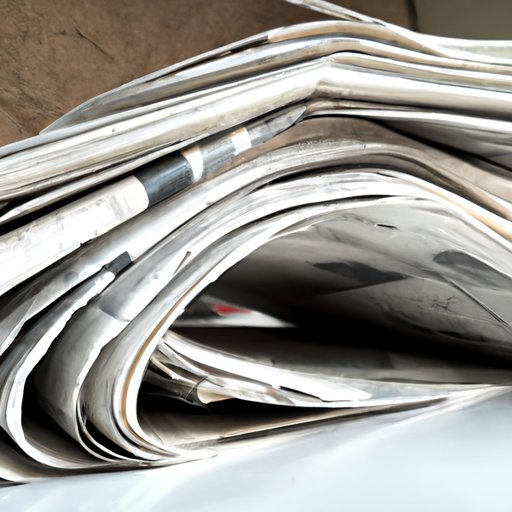Introduction
A newspaper is a periodical publication that contains news and other information about current events, as well as opinion pieces, advertisements, and other features. It is usually printed on paper and distributed on a regular basis, typically daily or weekly. Newspapers have been an important source of information for centuries, and their invention has had a profound impact on modern society.
In this article, we will explore when the newspaper was invented and how it has evolved over time. We will look at the development of newspaper technology, the rise of newsprint in society, and the beginnings of newspaper circulation.

A Historical Overview of Newspaper Printing and Distribution
The invention of the printing press in the 15th century revolutionized the production of books, pamphlets, and other printed materials. This marked the beginning of the era of mass-produced printed media and set the stage for the invention of the modern newspaper.
Exploring the Evolution of Newspaper Technology: The invention of the steam-powered rotary press in the 19th century further advanced the technology of printing newspapers. This new machine allowed for the rapid production of large quantities of newspapers and made it possible for them to be produced much more quickly and efficiently than before.
An Analysis of the Development of Print Journalism: With the invention of the rotary press, newspapers began to become more sophisticated. They began to include more in-depth reporting, feature stories, and investigative journalism. This marked the beginning of the modern era of print journalism.
Examining the Rise of Newsprint in Society
Investigating How Newspaper Production Has Changed Through Time: Over the years, the technology used to produce newspapers has continued to evolve. New machines and processes have been developed that allow for faster and more efficient production of newsprint. Today, many newspapers are produced using digital printing technology.
A Look at the Invention of the First Newspaper: The first newspaper was published in Germany in 1605. It was called the Relation, and it contained news and information about current events. The Relation was the first periodical publication of its kind and marked the beginning of the era of printed news.

Tracing the Beginnings of Newspaper Circulation
Early Examples of Printed News: After the invention of the first newspaper, other publications soon followed. By the 17th century, newspapers were being printed and circulated throughout Europe. These early newspapers often contained sensationalist stories and rumors about current events.
The Spread of Newspapers Across Europe: As newspapers became more popular, they began to spread to other countries. By the 18th century, newspapers were being printed and circulated in North America, Asia, and Africa. This marked the beginning of global newsprint circulation.
The Creation of the Modern Newspaper: By the 19th century, newspapers had become more sophisticated. They contained more in-depth reporting, feature stories, and investigative journalism. This marked the beginning of the modern era of newspaper production.
Conclusion
The invention of the newspaper has had a profound impact on modern society. It has allowed for the rapid dissemination of news and information, making it possible for people around the world to stay informed about current events. The invention of the printing press and the development of newspaper technology have enabled newspapers to become more sophisticated and efficient over time.
This article explored the history of newspaper technology, tracing its evolution from the early printed news to the modern newspaper. We examined the invention of the first newspaper and its subsequent spread across Europe. We also looked at how newspaper production has changed through time and how newspapers have become an important source of information in society.
In conclusion, the invention of the newspaper has had a major impact on modern society. Its invention has allowed for the rapid dissemination of news and information and has enabled newspapers to become more sophisticated and efficient over time.
(Note: Is this article not meeting your expectations? Do you have knowledge or insights to share? Unlock new opportunities and expand your reach by joining our authors team. Click Registration to join us and share your expertise with our readers.)
